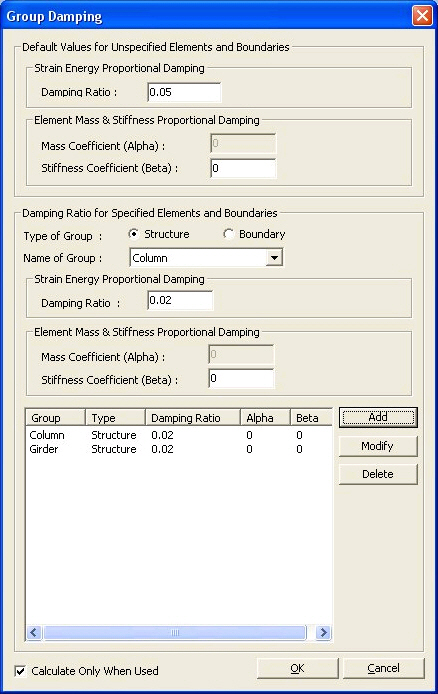Group Damping
|
|
|
|
|
|
Group Damping is used to assign different damping ratios resulting from time history analysis to different element and boundary groups.
When the materials, vibration control devices or vibration isolators in a structure have different damping ratios, elements with different damping ratios can be assigned to different Element Groups.
It is common to assign structural members such as beams and columns to a Structural Group and assign boundary conditions (including structures assigned with vibration isolators or vibration control devices) to a Boundary Group in order to define different damping ratios. |
|
|
|
|
|
|
|
From the Main Menu select Model > Properties > Group Damping
Select Geometry > Properties > Group Damping in the Menu tab of the Tree Menu. |
|
|
|
|
|
Group Damping dialog box
Default Values for Damping Ratio for Unspecified Elements and Boundaries
Apply damping ratio to the elements and boundaries unspecified by groups.
Strain Energy Proportional Damping
Specify a Damping Ratio, which will be used to calculate modal damping ratios in the case where Strain Energy Proportional is selected as the Damping Method in Time History Load Cases.
Element Mass & Stiffness Proportional Damping
Enter a coefficient, which will be multiplied with the element stiffness matrix to calculate modal damping ratios (Cele=Beta x Kele) and will be used in the case where Element Mass & Stiffness Proportional is selected as the Damping Method in Time History Load Cases.
Damping matrix for each element is applied when the direct integration method is used for analysis.
Alpha: Mass matrix coefficient for calculating damping matrix for each element
Beta: Stiffness matrix coefficient for calculating damping matrix for each element
Damping Ratio for Specified Elements and Boundaries
Assign damping ratios by element and boundary groups.
Type of Group
Structure: Select to assign damping ratios by element groups.
Boundary: Select to assign damping ratio by boundary groups. Available boundary conditions are Elastic Link, Nonlinear Link and Point Spring.
Name of Group: Select a group name, which was defined in Model>Group>Structural Group or Boundary Group.
Strain Energy Proportional Damping
Specify a Damping Ratio, which will be used to calculate modal damping ratios in the case where Strain Energy Proportional is selected as the Damping Method in Time History Load Cases.
Element Mass & Stiffness Proportional Damping
Enter a coefficient, which will be multiplied with the element stiffness matrix to calculate modal damping ratios (Cele=Beta x Kele) and will be used in the case where Element Mass & Stiffness Proportional is selected as the Damping Method in Time History Load Cases.
Damping matrix for each element is applied when the direct integration method is used for analysis.
Alpha: Mass matrix coefficient for calculating damping matrix for each element
Beta: Stiffness matrix coefficient for calculating damping matrix for each element
Note When elements or boundary conditions have not been assigned to Groups, damping ratios specified under 'Default Values for Unspecified Elements and Boundaries' are used for time history analysis. When elements or boundary conditions have been assigned to Groups, damping ratios specified under 'Damping Ratio for Specified Elements and Boundaries' are used for time history analysis.
Calculate Only When Used
If this option is checked on, modal damping ratios are calculated only when 'Strain Energy Proportional' is selected as the Damping Method in Time History Load Cases. If this option is not checked on, modal damping ratios are calculated for each Damping Method. (Result>Modal Damping Ratio Based on Group Damping)
|
|
|
